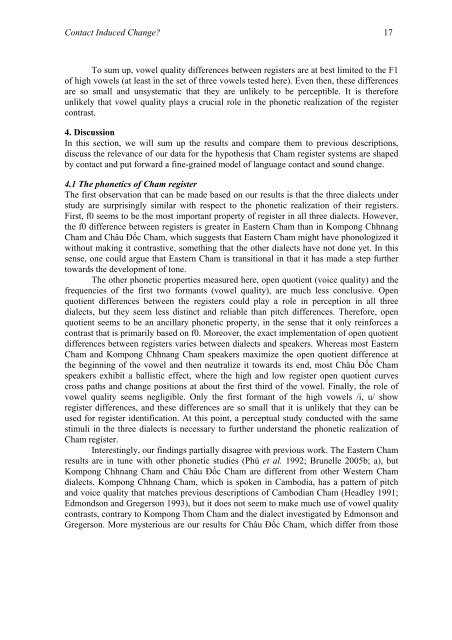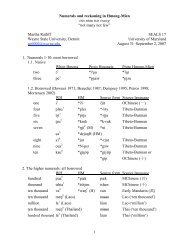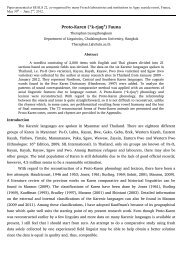proto-southwestern-tai revised: a new reconstruction - seals 22
proto-southwestern-tai revised: a new reconstruction - seals 22
proto-southwestern-tai revised: a new reconstruction - seals 22
Create successful ePaper yourself
Turn your PDF publications into a flip-book with our unique Google optimized e-Paper software.
Contact Induced Change? 17<br />
To sum up, vowel quality differences between registers are at best limited to the F1<br />
of high vowels (at least in the set of three vowels tested here). Even then, these differences<br />
are so small and unsystematic that they are unlikely to be perceptible. It is therefore<br />
unlikely that vowel quality plays a crucial role in the phonetic realization of the register<br />
contrast.<br />
4. Discussion<br />
In this section, we will sum up the results and compare them to previous descriptions,<br />
discuss the relevance of our data for the hypothesis that Cham register systems are shaped<br />
by contact and put forward a fine-grained model of language contact and sound change.<br />
4.1 The phonetics of Cham register<br />
The first observation that can be made based on our results is that the three dialects under<br />
study are surprisingly similar with respect to the phonetic realization of their registers.<br />
First, f0 seems to be the most important property of register in all three dialects. However,<br />
the f0 difference between registers is greater in Eastern Cham than in Kompong Chhnang<br />
Cham and Châu Đốc Cham, which suggests that Eastern Cham might have phonologized it<br />
without making it contrastive, something that the other dialects have not done yet. In this<br />
sense, one could argue that Eastern Cham is transitional in that it has made a step further<br />
towards the development of tone.<br />
The other phonetic properties measured here, open quotient (voice quality) and the<br />
frequencies of the first two formants (vowel quality), are much less conclusive. Open<br />
quotient differences between the registers could play a role in perception in all three<br />
dialects, but they seem less distinct and reliable than pitch differences. Therefore, open<br />
quotient seems to be an ancillary phonetic property, in the sense that it only reinforces a<br />
contrast that is primarily based on f0. Moreover, the exact implementation of open quotient<br />
differences between registers varies between dialects and speakers. Whereas most Eastern<br />
Cham and Kompong Chhnang Cham speakers maximize the open quotient difference at<br />
the beginning of the vowel and then neutralize it towards its end, most Châu Đốc Cham<br />
speakers exhibit a ballistic effect, where the high and low register open quotient curves<br />
cross paths and change positions at about the first third of the vowel. Finally, the role of<br />
vowel quality seems negligible. Only the first formant of the high vowels /i, u/ show<br />
register differences, and these differences are so small that it is unlikely that they can be<br />
used for register identification. At this point, a perceptual study conducted with the same<br />
stimuli in the three dialects is necessary to further understand the phonetic realization of<br />
Cham register.<br />
Interestingly, our findings partially disagree with previous work. The Eastern Cham<br />
results are in tune with other phonetic studies (Phú et al. 1992; Brunelle 2005b; a), but<br />
Kompong Chhnang Cham and Châu Đốc Cham are different from other Western Cham<br />
dialects. Kompong Chhnang Cham, which is spoken in Cambodia, has a pattern of pitch<br />
and voice quality that matches previous descriptions of Cambodian Cham (Headley 1991;<br />
Edmondson and Gregerson 1993), but it does not seem to make much use of vowel quality<br />
contrasts, contrary to Kompong Thom Cham and the dialect investigated by Edmonson and<br />
Gregerson. More mysterious are our results for Châu Đốc Cham, which differ from those





